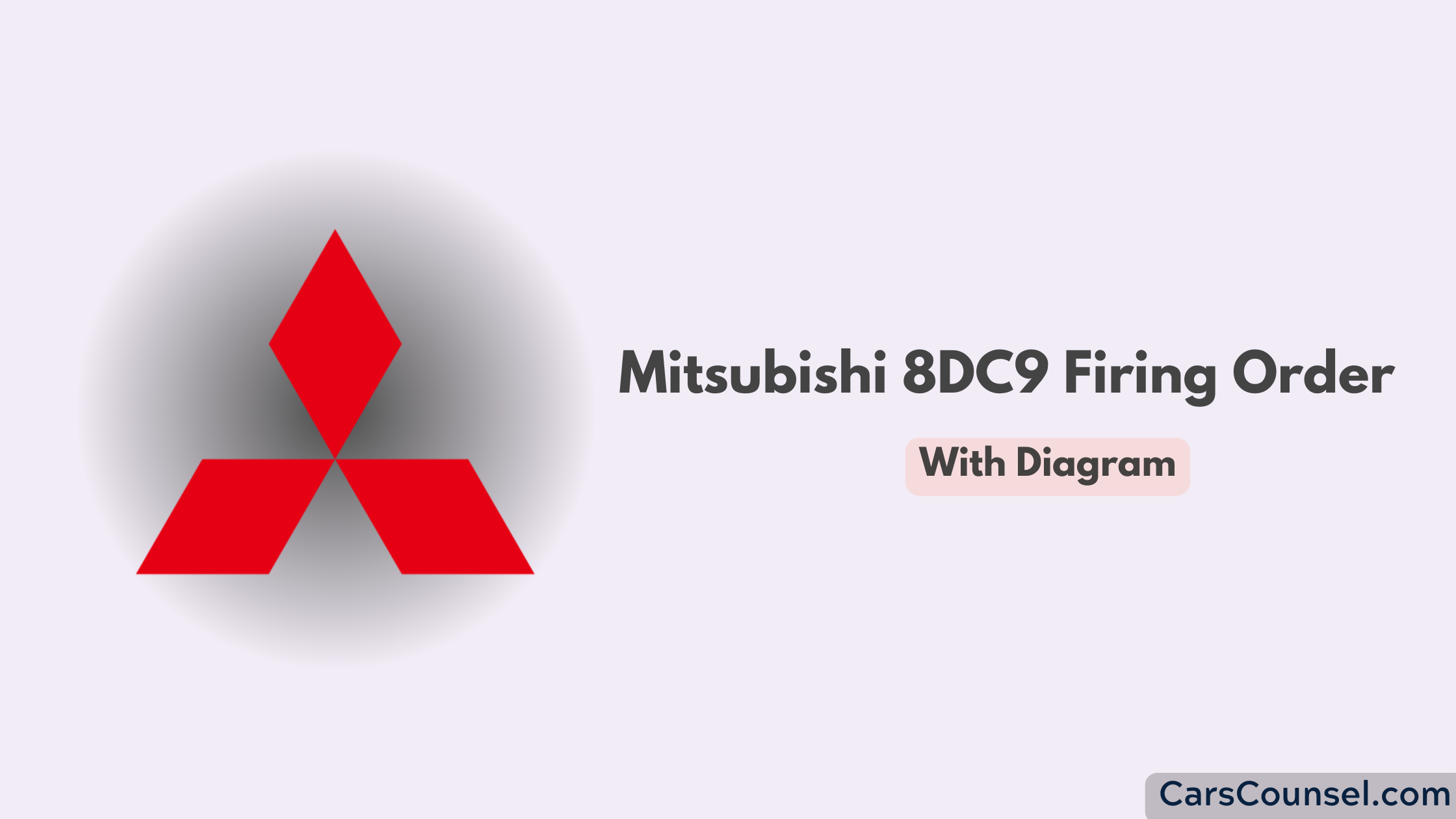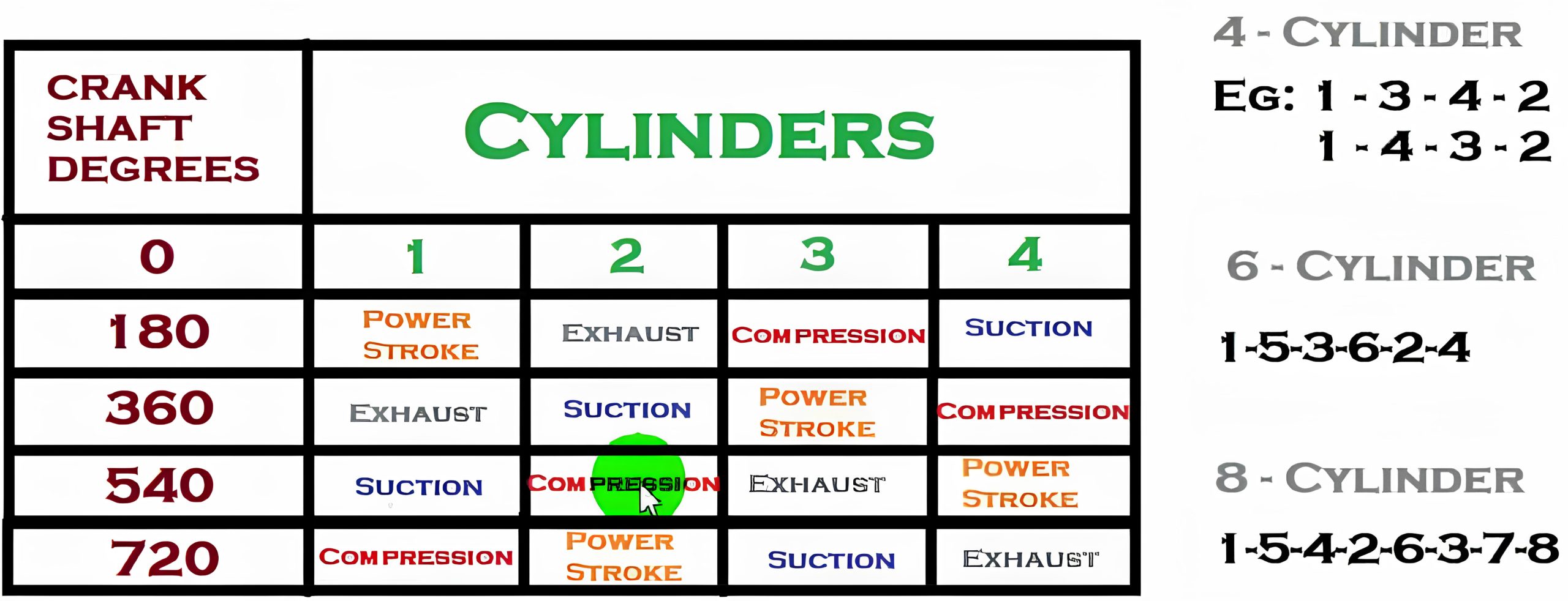The Mitsubishi 8DC9 engine is a robust, high-performance V8 diesel engine widely used in heavy-duty trucks, buses, and industrial applications. Known for its power, durability, and reliability, the 8DC9 engine is a trusted workhorse in the commercial vehicle industry. A critical aspect of its operation is the firing order, which ensures smooth performance and efficient power delivery.
In this guide, we’ll break down the firing order for the Mitsubishi 8DC9 engine, explain its significance, and provide practical tips for maintenance and troubleshooting. Whether you’re a mechanic, an operator, or just curious about engine mechanics, this article will give you a clear understanding of the 8DC9 firing order.

Quick Navigation
The Mitsubishi 8DC9 Firing Order
The firing order for the Mitsubishi 8DC9 engine is: 1-5-4-2-6-3-7-8

How the Firing Order Works
- Cylinder 1 Fires First: Located on Bank 1, the frontmost cylinder starts the sequence.
- Cylinder 5 Fires Second: Ignition moves to the third cylinder on Bank 1.
- Cylinder 4 Fires Third: The second cylinder on Bank 2 ignites.
- Cylinder 2 Fires Fourth: The frontmost cylinder on Bank 2 fires next.
- Cylinder 6 Fires Fifth: Combustion moves to the third cylinder on Bank 2.
- Cylinder 3 Fires Sixth: Ignition returns to the second cylinder on Bank 1.
- Cylinder 7 Fires Seventh: The rearmost cylinder on Bank 1 fires next.
- Cylinder 8 Fires Last: The rearmost cylinder on Bank 2 completes the sequence.
This sequence alternates firing events between the two banks, ensuring balanced operation and smooth power delivery.
Why Mitsubishi Uses the 1-5-4-2-6-3-7-8 Firing Order
The 1-5-4-2-6-3-7-8 firing order was carefully selected for the 8DC9 engine to achieve optimal performance. Here’s why it works:
- Minimized Vibrations: The sequence alternates firing between banks, reducing vibration and improving engine stability.
- Consistent Torque Output: Ensures that power strokes are evenly distributed, maintaining steady performance.
- Improved Efficiency: Proper spacing of combustion events allows for optimal fuel-air mixture combustion.
- Durability: Balancing the firing order reduces mechanical stress on the crankshaft and bearings, extending engine life.
What Is a Firing Order?
The firing order refers to the sequence in which an engine’s cylinders fire or ignite the air-fuel mixture. In diesel engines like the 8DC9, ignition occurs through high compression, generating the power needed to drive the crankshaft and deliver torque to the wheels.
The firing order is carefully designed to balance mechanical loads and ensure smooth operation.
Why the Firing Order Is Important
- Smooth Operation: A well-planned firing order minimizes vibrations, keeping the engine stable and efficient.
- Balanced Power Delivery: Alternating combustion events across cylinders ensures consistent torque output.
- Efficiency: Proper firing reduces fuel wastage and maximizes combustion efficiency.
- Durability: A balanced sequence reduces stress on internal components, extending the engine’s lifespan.
Overview of the Mitsubishi 8DC9 Engine
The Mitsubishi 8DC9 is a V8, turbocharged, diesel engine. Designed for heavy-duty use, this engine offers impressive torque and power output, making it ideal for demanding applications. Its V8 configuration provides compactness and power, allowing it to fit into large vehicles while delivering excellent performance.
Key Features of the 8DC9 Engine
- V8 Layout: Eight cylinders arranged in two banks of four, forming a “V” shape.
- Diesel Combustion: Operates on compression ignition rather than spark ignition.
- Turbocharged: Boosts power output and efficiency by forcing more air into the cylinders.
- Cylinder Numbering:
- Bank 1: Cylinders 1, 3, 5, 7 (front to back).
- Bank 2: Cylinders 2, 4, 6, 8 (front to back).
Identifying the Firing Order
Understanding and verifying the firing order is essential for maintenance and troubleshooting. Here are the steps to identify and confirm the firing order in the Mitsubishi 8DC9 engine:
Refer to the Engine Manual
The engine manual provides detailed information about the firing order and cylinder numbering. This is your go-to resource for technical details.
Cylinder Numbering
The cylinder numbers are typically stamped on the engine block or identified in the manual. Familiarize yourself with the V8 layout:
- Bank 1: Cylinders 1, 3, 5, 7
- Bank 2: Cylinders 2, 4, 6, 8
Use Diagnostic Tools
Use timing tools or software diagnostics to confirm that the engine is firing in the correct sequence. These tools can also identify misfires.
Symptoms of an Incorrect Firing Order
An incorrect firing order can cause significant performance and operational issues. Recognizing these symptoms can help you identify and address the problem quickly.
Common Symptoms
- Engine Misfires: Cylinders fail to fire properly, leading to uneven power delivery.
- Rough Idling: The engine vibrates excessively or feels unstable when idling.
- Power Loss: Reduced torque and power output make it difficult to operate the vehicle efficiently.
- Unusual Noises: Knocking, pinging, or backfiring sounds may occur due to improper timing.
- Increased Fuel Consumption: Inefficient combustion leads to higher fuel usage and emissions.
Diagnosing and Fixing Firing Order Problems
If you suspect an issue with the firing order in your 8DC9 engine, follow these steps to diagnose and resolve it:
Diagnostic Steps
- Inspect Cylinder Connections: Ensure that the injector lines or ignition wiring is connected to the correct cylinders.
- Verify Timing: Use a timing light or diagnostic tool to confirm that the engine’s timing matches the manufacturer’s specifications.
- Perform a Compression Test: Check each cylinder’s compression to ensure they are firing correctly.
- Scan for Error Codes: Use an onboard diagnostic system (if available) to identify specific misfire-related issues.
Fixing Common Issues
- Reconnect Injector Lines: If injector lines are incorrectly routed, reattach them in the proper sequence.
- Adjust Timing: Use timing tools to realign the engine’s timing components.
- Replace Faulty Components: Replace damaged injectors, valves, or sensors that may be causing misfires.
Preventative Maintenance for Firing Order Reliability
To ensure the firing order remains correct and the engine operates efficiently, follow these preventative maintenance tips:
Regular Inspections
- Check injector lines and wiring for signs of wear or incorrect connections.
- Inspect the timing belt or chain for proper alignment.
Replace Worn Components
- Replace injectors, valves, and timing components according to the manufacturer’s recommended intervals.
- Use high-quality OEM parts to maintain reliability.
Maintain Timing Accuracy
- Periodically check and adjust the timing to prevent firing order issues.
- Ensure proper alignment of timing marks during major maintenance or rebuilds.
FAQs About the Mitsubishi 8DC9 Firing Order
Can I Change the Firing Order?
No, the firing order is determined by the engine’s design and crankshaft configuration. Altering it would require significant modifications.
What Happens If the Firing Order Is Incorrect?
An incorrect firing order can cause engine misfires, rough operation, power loss, and potential damage to internal components.
How Can I Verify the Firing Order?
Use the engine manual, inspect cylinder connections, and confirm timing with diagnostic tools or a timing light.
Conclusion
The 1-5-4-2-6-3-7-8 firing order is a crucial aspect of the Mitsubishi 8DC9 engine’s operation. It ensures smooth performance, balanced power delivery, and efficient combustion—qualities essential for heavy-duty applications. Understanding and maintaining this firing order is key to keeping your 8DC9 engine running at peak performance.
By following proper maintenance practices, verifying timing, and addressing issues promptly, you can maximize the lifespan and efficiency of your engine. Whether you’re managing a fleet or maintaining a single vehicle, knowing the firing order is a vital step in mastering the Mitsubishi 8DC9.

